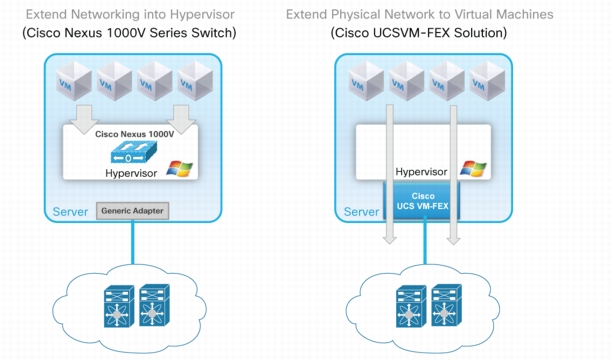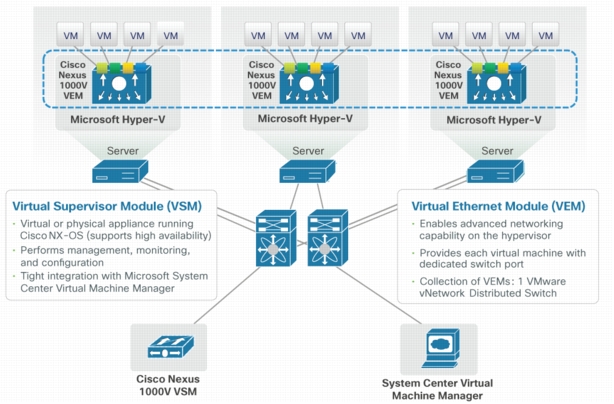
For enterprise and service provider customers who want to extend Cisco networking experience to their Microsoft Windows Server 8 Hyper-V deployments, Cisco offers a full portfolio of virtual networking technologies through the Cisco Nexus 1000V Series Switches and Cisco Unified Computing System(Cisco UCS) Virtual Machine Fabric Extender (VM-FEX).
The Cisco Nexus 1000V Series is a distributed virtual switching platform that provides advanced networking features, integrated virtual services, and a consistent operational model across physical and virtual environments. Customers can rely on the robust Cisco NX-OS Software command-line interface (CLI) and feature set and Cisco’s innovative network services architecture for their virtual environments.
Cisco UCS VM-FEX simplifies virtual machine networking by collapsing virtual and physical networking into a single easy-to-manage infrastructure while using Hyper-VSingle-Root I/O Virtualization (SR-IOV) technology to provide near-bare-metal I/O performance to the virtual machines.
Challenge
Server virtualization provides numerous benefits to data center customers; however, the dynamic nature of virtual environments also presents additional complexities for communication between virtual machines. In a virtualized environment, multiple virtual machines share the same hardware infrastructure and move from one server to another (or across data centers), and some virtual machine-to-virtual machine traffic never reaches the physical switch.
This dynamic environment poses the following questions for the virtualization customer:
• How can I provision network policies with virtual machine-level details?
• How can I enforce consistent network and security policies when virtual machines move?
• How can I troubleshoot communication problems between virtual machines?
• How can I reuse the existing investments made for the physical network?
One additional complexity is based in the operational model: most current virtualization management tools concentrate the operational duties for computing, networking, and storage resources in the hands of a single virtualization administrator. This approach both complicates the job of the virtualization administrator and creates additional organizational complexity in the management of physical and network infrastructures.
Cisco offers two options to help virtualization customers address these problems (Figure 1):
• Extend enterprise-class networking functions to the hypervisor layer with Cisco Nexus 1000V Series Switches.
• Extend physical network to the virtual machine with Cisco UCS VM-FEX.
Figure1. Cisco Virtual Networking Solution Options
Business Benefits
Cisco Virtual Networking solutions reduce the operational complexities associated with virtual machine-to-virtual machine networking and thus help customers gain more of the benefits of server virtualization technology.
Cisco Virtual Networking solutions offer the following benefits:
• Preserves your existing investments in network operation models and management tools
– Network administrators can manage network policies across the physical and virtual environments using the same interfaces (Cisco NX-OS CLI), and staff members do not need to be retrained.
– Customers can use existing network monitoring and management tools to manage both physical and virtual environments.
• Simplifies virtual networking operations
– Visibility into the traffic between virtual machines simplifies virtual machine-to-virtual machine network troubleshooting.
– Virtualization-aware networking features simplify virtual machine network policy management.
– Tight integration with the Microsoft System Center portfolio allows faster policy provisioning, and clear separation of roles between server and network administrators.
• Provides better security
– Virtualization-aware networking provides better security by extending network policies and network visibility to the virtual machine level.
Solution
Cisco offers two solutions based on the Hyper-V extensible switch framework to extend advanced networking features to Hyper-V virtual environments. Customers can choose the solution that best fits their needs. The Cisco Nexus 1000V Series is a software-based solution focused on extending advanced features and integrated services with a flexible deployment model, and Cisco UCS VM-FEX is a hardware-based solution that offers simplified management and near-bare-metal I/O performance.
Extend Networking Functions to the Hypervisor Layer Using Cisco Nexus 1000V Series
For customers who want to extend comprehensive networking capabilities to their virtualization environments with a flexible deployment model, the Cisco Nexus 1000V Series provides an excellent solution. It uses the Microsoft Hyper-V Extensible switch framework to bring advanced virtualization-aware networking functions into the hypervisor layer.
Like other distributed modular Cisco switches, Cisco Nexus 1000V Series Switches consist of two components (Figure 2):
• Virtual Ethernet module (VEM): A software line card that is embedded in Hyper-V deployed on each host; each virtual machine on the host is connected to the VEM through a virtual Ethernet (vEth) port
• Virtual supervisor module (VSM): The management module that controls multiple VEMs and helps define virtual machine-centric network policies; this module is similar to the supervisor module on a physical modular switch
Figure2. Cisco Nexus VEM and VSM Components
In addition to these two modules, Cisco Nexus 1000V Series Switches include Cisco vPath technology and extend multiple network services to the virtual environments.
The following virtual networking services are currently available for the Cisco Nexus 1000V Series:
• Cisco Virtual Security Gateway (VSG): Provide detailed, zone-based security policies for multi-tenant virtual environments.
• Cisco Virtual Wide Area Application Services (vWAAS): Provide assured application performance acceleration to users connected to enterprise data centers and enterprise private clouds.
• Cisco Network Analysis Module (NAM): Provide actionable visibility to troubleshoot performance problems in for your virtual environments.
For customers looking for a dedicated hardware appliance to host all the Nexus 1000V related virtual appliances (VSM, VSG, vWAAS, NAM etc.), Cisco offers the Nexus 1010 Virtual Services Appliance. With the Cisco Nexus 1010, network administrators do not need to rely on server administrators to run networking appliances, and this reduces the operational complexity of virtualized data center environments.
Extend Physical Network to Virtual Machine with Cisco UCS VM-FEX
For Cisco UCS customers who want a simpler management model and near bare-metal performance for their virtualized workloads, Cisco UCS VM-FEX offers a compelling solution.
Cisco UCS VM-FEX is an extension of the fabric extender technology pioneered by Cisco. When connected to a Cisco Nexus 5000 Series Switch or Cisco UCS fabric interconnect, fabric extenders act as remote line cards of the Cisco Nexus 5000 Series or Cisco UCS fabric interconnect. Fabric extender technology helps enable customers to achieve the benefits of simplified management of chassis-based modular switches and the convenience of top-of-rack deployment.
Cisco UCS VM-FEX extends this technology all the way to the virtual machines. Each virtual machine is connected to a dedicated virtual Ethernet port on the Cisco UCS fabric interconnect, and all virtual machine traffic is sent directly to this virtual Ethernet port on the fabric interconnect. This virtual Ethernet port can be configured, managed, monitored, and debugged just like a physical port on the Cisco UCS fabric interconnects (Figure3).
Figure3. Cisco UCS VM-FEX Extends Cisco Fabric Extender Technology with Cisco UCS Fabric Interconnects
Cisco UCS VM-FEX solutions offer multiple benefits to virtualization customers:
• Operation simplicity: Collapsing the physical and virtual networking layers into one reduces the number of management points that the network administrator has to monitor, and offers the same consistent feature set and infrastructure for both virtual and physical infrastructures.
• Improved performance: By using Microsoft Hyper-V SR-IOV functionality, this solution offers near-bare-metal performance for virtual workloads.
Original resource and more from: Cisco Virtual Networking: Extend Advanced Networking for Microsoft Hyper-V Environments





